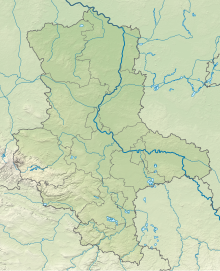Saale-Ilm-Platten near Bad Kösen
Coordinates: 51 ° 7 ′ 39 ″ N , 11 ° 44 ′ 15 ″ E
The Saale-Ilm-Platten near Bad Kösen are a nature reserve in the town of Naumburg (Saale) in the Burgenland district in Saxony-Anhalt .
The nature reserve with the registration number NSG 0198 is approximately 640 hectares . It is fully part of around 718 hectares, the same FFH area and a large part of the conservation area surrounded "Saale". The area has been under protection since 2000 (date of regulation: July 20, 2000). The “Mordtal und Platten” nature reserve east of Bad Kösen, which was designated on May 1, 1961, has been incorporated into the nature reserve. This was initially around 188 hectares, but was reduced to 66.8 hectares in 1989 because large parts of the beech forest had been felled and the areas had been afforested with larches and white pines . The responsible lower nature conservation authority is the Burgenlandkreis.
The nature reserve is located southwest of Naumburg (Saale) in the Saale-Unstrut-Triasland nature park . It places a wavy shell limestone plateau, which connects to the Ilm-Saale-Platte , under protection. The plateau drops to the northwest to the partially deeply cut Saale valley . In predominantly wooded conservation area are different forest communities to find, including beech forests , wood-rush-beech forests, sessile oak and hornbeam forests and oak forests dry expression. The red beech forests that predominate on the plateau areas only have a thin layer of shrubbery . The herb layer is u. a. formed by forest barley , single-flowered pearl grass , golden nettle and spring pea. The sessile oak-hornbeam forests are in their forest rennet form with a well-developed shrub layer of hawthorn, common hazel and European eucoat , but also with field maple and heat-loving species in the herb layer, e.g. B. Ebony marguerite as well as extensive coppice forests with common hazel, summer linden and pale orchid . Orchid beech forests with long-leaved forest birds and brown-red sitters grow on shallow limestone slopes . Moist locations are occupied by chickweed, pedunculate oak and hornbeam forests with ash, in the area of the Kleiner Saale in the north-east of the nature reserve, black cherry, alder and ash forests and, in some places, softwood forests . Furthermore, the Kleine Saale is accompanied by wet grassland , reed beds and turf . The predominantly near-natural forest communities in the nature reserve have a high proportion of dead wood .
On slopes that are grazed with sheep and free of forest, there is fusilage-feather-twig-half dry grass with snowball and dogwood bushes . Here u. a. Small beaver pit , mountain aster and sickle-leaved hare's ear as well as various orchids , including large two -leaved , fly's garwort , bee's garwort , three-tooth orchid and purple orchid . In the transition area to the Saale valley, there are old orchards with partially bushy, semi-arid grass and oat meadows. Rare wild herb communities also occur in the nature reserve. Other noteworthy plant species are silver thistle , pasque flower , rue , summer and spring adonis and dull speedwell . One occurrence of the common women mirror is limited to this region of Saxony-Anhalt.
The nature reserve is the habitat of a species-rich fauna. The forest communities provide a habitat for all woodpecker species as well as stock doves and tawny owls. Furthermore, the red kite , honey buzzard , sparrowhawk and goshawk as well as great gray shrike , quail , barnacle warbler , whinchat and stonechat are native to the nature reserve. The gray wagtail and kingfisher live on the Kleine Saale . The near-natural forest areas are the habitat of the pine marten , while the open land areas of ermine , mouse weasel and polecat offer a suitable habitat.
The invertebrate fauna in the nature reserve is also worth mentioning. One of the few occurrences of the hardwood saber hedge and the common hunk is here in Saxony-Anhalt. Mourning cloak , stag beetle and reddish daudebardia also live here , a species of snail that is bound to deadwood and near-natural forests and that reaches the northern limit of its Central and Southern European range. Several dragonflies , including the banded darter, live in a few small bodies of water in the nature reserve and in the Kleiner Saale .
The nature reserve borders on the plateau areas mainly on agricultural areas , which occasionally protrude into the nature reserve. Individual grassland areas are located within the nature reserve. In the Saale valley, the nature reserve borders on other agricultural areas, but often also on residential and commercial areas. At Saaleck , the nature reserve extends over a short section on the left bank of the Saale. The Saale is included here in the nature reserve. Through the forests run numerous forest and rural roads , many of the trails can be used. Between Bad Koesen and Kukulau and Kleinheringen and Rödigen run county roads through the nature reserve.
The planned bypass of Bad Kösen and Naumburg (Saale) along the federal highway 87 would touch the nature reserve in the far west between Kleinheringen and Rödingen.
See also
Web links
Individual evidence
- ↑ Order No. 1 on nature reserves , Journal of Laws of the German Democratic Republic, May 4, 1961 (PDF, 101 kB). Retrieved April 18, 2018.
- ↑ Saale-Ilm-Platten near Bad Kösen , nature reserves, January 1, 2003, p. 195. Accessed on July 23, 2015.
- ↑ a b c Saale-Ilm-Platten near Bad Kösen , Nature Conservation Areas, January 1, 2003, pp. 197–198. Retrieved July 23, 2015.
- ^ New building B87 OU Bad Kösen , engineering office for traffic systems (PDF, 2.1 MB). Retrieved May 16, 2019.



